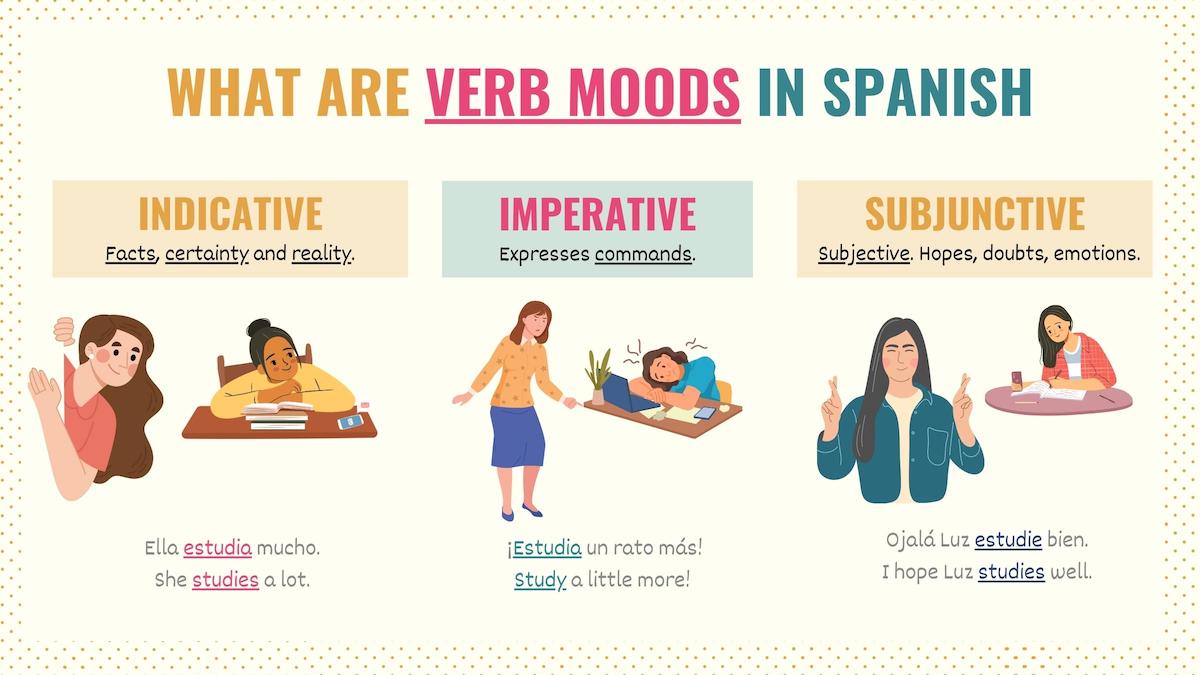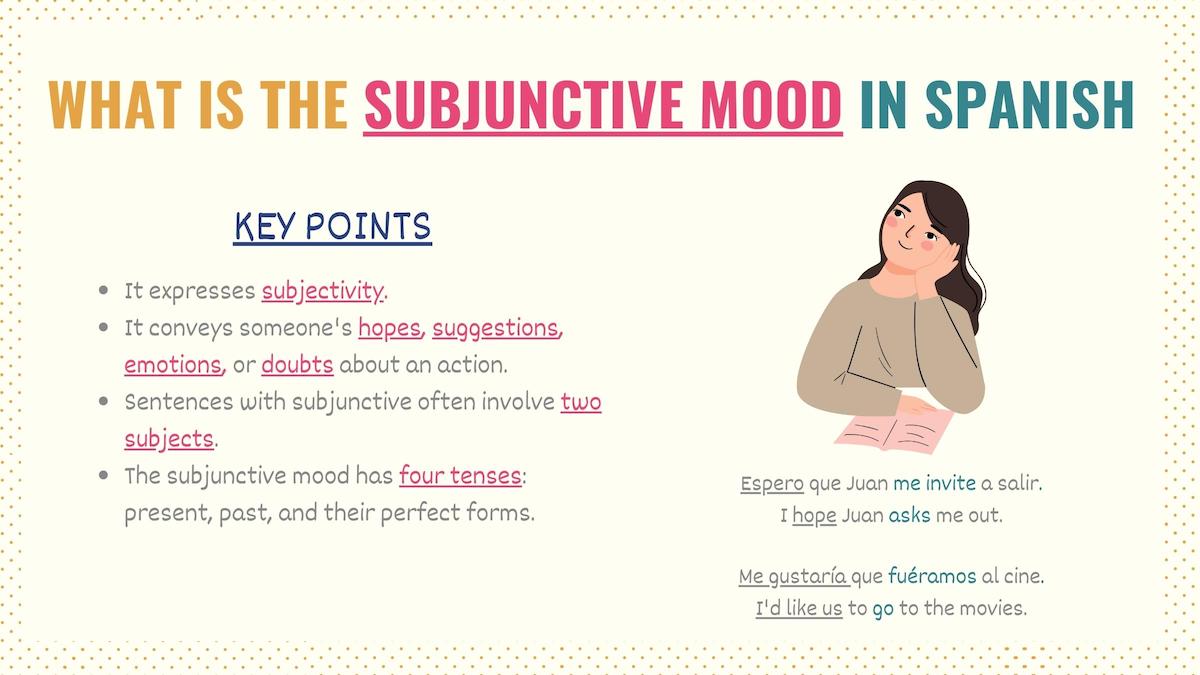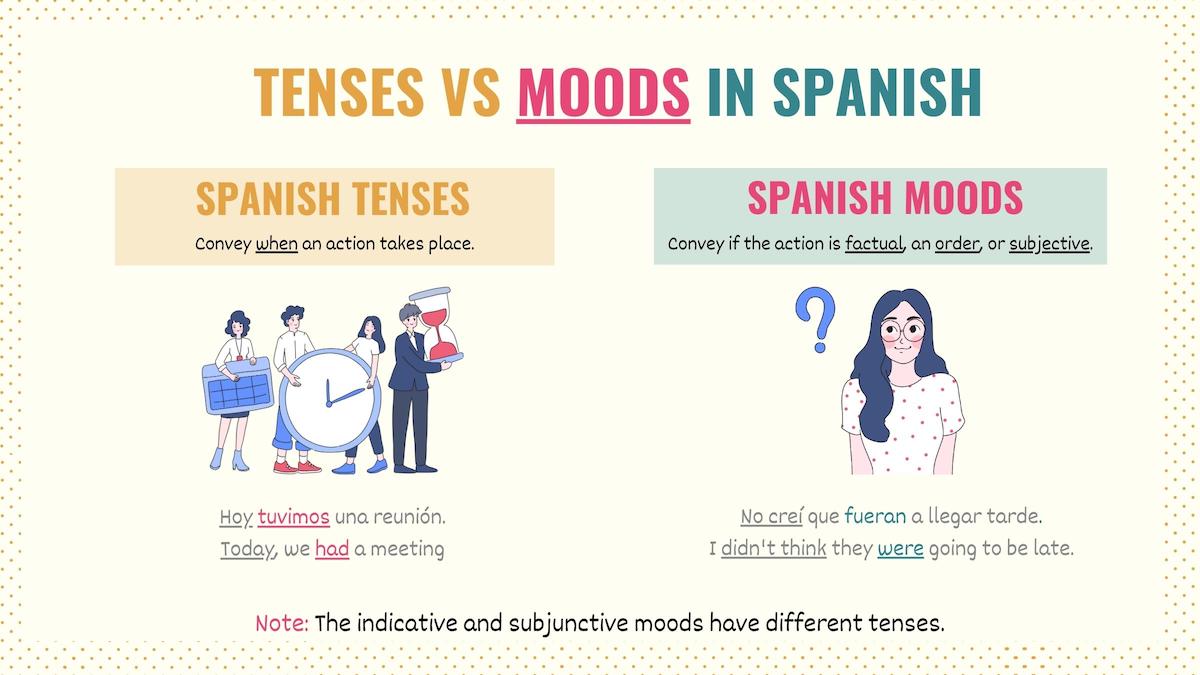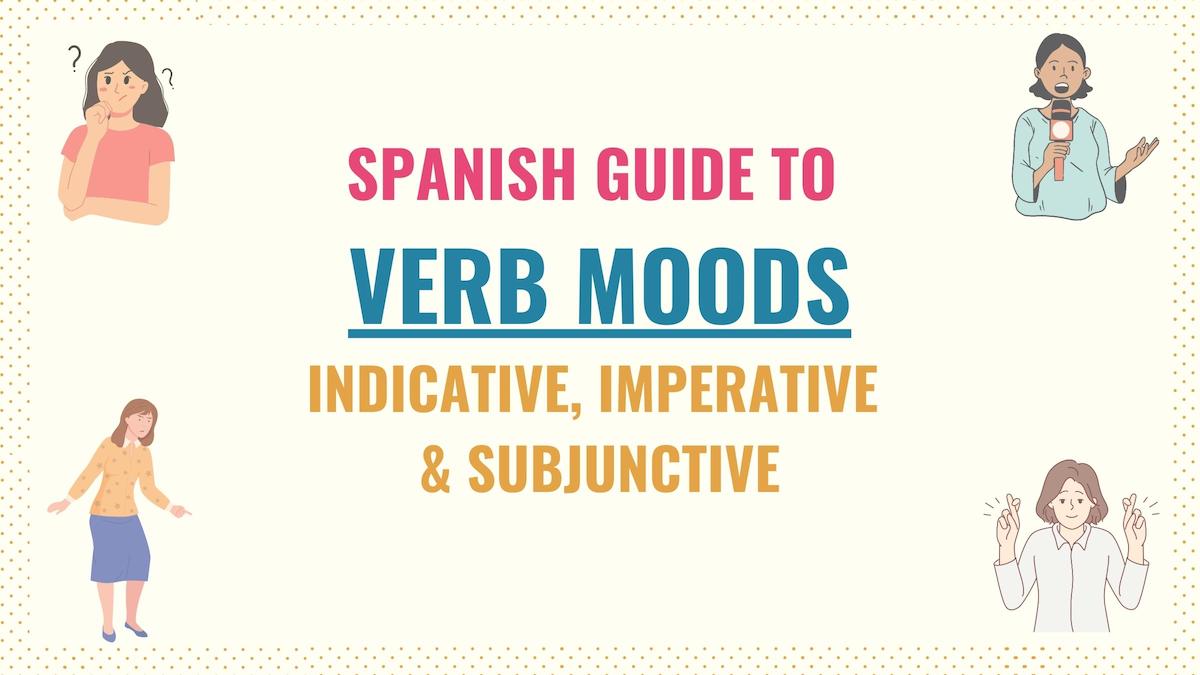Verb mood in Spanish allows you to convey your perspective about the information you share. In short, understanding how Spanish moods work is crucial to accurately expressing ideas and conveying different shades of meaning.
Since this topic is critical to improving your fluency, in this guide, we’ll go over:
- What Is Verb Mood & Different Moods
- Spanish Tenses vs Moods
- Key Points
- Next Steps to Master Spanish Moods
Mood in Spanish: What Is It & Different Moods
In Spanish, moods convey the speaker’s attitude toward the state or action expressed by the verb. In simple words, verb moods share how the speaker perceives the information. Spanish moods are indicative (facts, reality), imperative (commands), and subjunctive (feelings, wishes, doubts).
Check these sentences using the same verb (comer) in different moods:
Indicative
Laura come muchos dulces.
Laura eats a lot of candies.
Imperative
Laura, ¡come más dulces!
Laura, eat more candies!
Subjunctive
Espero que Laura no coma más dulces.
I hope Laura doesn’t eat more candies.
The sentences above refer to the same action – Laura eating candies. However, the attitude and how we convey this information varies depending on the Spanish mood used.
In the first sentence, I objectively describe what Laura does. However, in the second example, I command her to do something. Finally, sentence #3 conveys subjectivity (what I hope Laura will do).
Unlike the Spanish imperative mood, the indicative and subjunctive moods can be conjugated in different tenses. In the following sections, you’ll learn more about the specifics of each verb mood in Spanish.

Indicative mood in Spanish
The Spanish indicative mood refers to actions or states the speaker perceives as factual or real. The indicative mood has five main tenses to express when this information takes place:
- Present indicative: Refers to habitual actions, current events, or actions taking place at the moment of speaking.
- Preterite: This Spanish past tense is used to talk about actions or states that took place at a specific moment in the past.
- Imperfect: Use the past imperfect tense to describe habitual past actions or express how something used to be in the past.
- Future simple: Indicates that an action or event will take place at some future time.
- Conditional simple: Refers to actions that depend on a condition for them to take place.
Here are some sentences using the indicative mood in Spanish:
Robert y Bill trabajan todo el día.
Robert and Bill work all day.
Creo que Joan fue al dentista.
I think Joan went to the dentist.
En unos días, iremos al cine.
We will go to the movies in a few days.
Mi perro era blanco y se llamaba Firulais.
My dog was white, and his name was Firulais.
Iríamos contigo, pero tenemos mucho trabajo.
We would go with you, but we have a lot of work.
Take Note: These tenses have progressive and compound forms to help you pinpoint an action more precisely.
Subjunctive mood in Spanish
The subjunctive mood relates to the speaker’s subjectivity. This verb mood in Spanish expresses the speaker’s hopes, suggestions, feelings, and doubts about an action. The subjunctive can be conjugated in four main tenses:
- Present subjunctive: Express someone’s current emotions, wishes, and uncertainty about a present situation.
- Present perfect subjunctive: Refers to current doubts, hopes, or feelings regarding an action that has already happened and is still connected to the present.
- Past subjunctive: It’s used to talk about someone’s past wishes, requests, hopes, or doubts someone had.
- Past perfect subjunctive: Communicates past regrets or wishes that were never accomplished, and conjectures about what could have happened.
Here are some sentences with the subjunctive mood:
Espero que tengas un buen día.
I hope you have a good day.
Dudo que ustedes hayan leído el artículo
I doubt that you guys have read the article.
Te pedí que llevaras a tu hermana a la tienda.
I asked that you take your sister to the store.
Ojalá hubiéramos ido al concierto.
I wish we had gone to the concert.
Notice that the subjunctive relates to imaginary or hypothetical actions – things that have not happened or never did.
Take Note: Sentences with the subjunctive mood often involve two subjects. The first subject represents the person with the feelings, suggestions, hope, or uncertainty. The second subject is the person to whom that subjectivity is directed.

Spanish imperative mood
The imperative mood is used to give commands in Spanish. Simply put, with this mood, the speaker perceives and conveys the action as an order or straightforward request. The Spanish imperative can be composed as a negative or affirmative command.
Here are some examples:
Niños, limpien sus zapatos.
Niños, clean your shoes.
Martha, no cierres la puerta.
Martha, don’t close the door.
Por favor, haga lo que le dije.
Please, do as I told you.
Take Note: The imperative is not considered a tense but a mood. In other words, unlike the indicative and subjunctive, this Spanish mood doesn’t place an action at different moments in time.
Tenses vs Verb Moods in Spanish
Although they relate to Spanish verbs, tenses and moods are not the same.
Verb tenses in Spanish locate an action in time. In other words, they refer to the time when an action takes place. Present, past, and future are examples of tenses.
On the other hand, verb moods in Spanish convey whether the action is perceived as factual (indicative), as an order (imperative), or as a wish, doubt, or request (subjunctive). To better describe someone’s perception, some moods have different tenses.
Check this sentence:
Mi vecino tiene dos gatos.
My neighbor has two cats.
This sentence uses the present indicative. Together, the tense (present) and the mood (indicative) convey that this information is real in the present.

Key Points
Verb mood in Spanish is crucial for conveying clear and effective messages. Here are some key points to remember:
- Verb moods express how people perceive information.
- Depending on this perception, there are three moods.
- The indicative mood in Spanish refers to actions or states perceived as real or true. It’s objective.
- Use the Spanish imperative mood to command people to do or not do something.
- The subjunctive mood in Spanish conveys a subjective perception. It refers to someone’s wishes, doubts, suggestions, or emotions toward an action.
- Sentences with subjunctive often involve two subjects.
- The indicative and subjunctive moods have different tenses to better place an action in time.
Spanish Moods Additional Resources
Now that you better understand verb mood in Spanish, here are the next resources to check out.
Because it allows you to talk about what you do, your memories, and your plans, the indicative is the most common and basic mood in Spanish. So, make sure you know when and how to use it. Also, check the different applications and conjugation rules of the Spanish imperative.
For many learners, the subjunctive mood can be challenging. However, this mood is necessary and common in daily Spanish. Therefore, you must get familiar with its uses, applications, rules, and conjugations.
To practice these conjugations, you can check our verb conjugation hub, where you’ll find conjugation guides and quizzes for the most important verbs in Spanish.
While you need to know all three moods to become fluent in Spanish, modern Spanish doesn’t use all the existing tenses. You only need to know 14 tenses in total. You can check out the 14 must-know Spanish tenses to see which tenses you need to learn next.
Download the Verb Mood in Spanish PDF
While tenses are more commonly discussed when learning to conjugate verbs, verb mood in Spanish is important to understand. It can also take time to familiarize yourself with this grammar topic. Download a free PDF containing all the graphics and key points from this guide on how to use the Spanish indicative, subjunctive and imperative moods.



